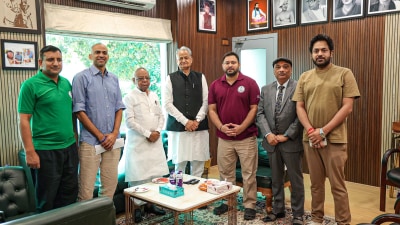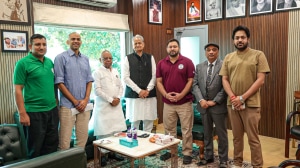A ravine, a river, hills and forests: terrain helps terror
If there is one main reason why the encounter between the security forces and the militants entered its fourth day here today, it’s geo...

If there is one main reason why the encounter between the security forces and the militants entered its fourth day here today, it’s geography.
A densely forested ravine, about a thousand feet deep, stretching for at least three kilometres, ringed by steep hills on three sides, a tributary of the Ujh river on the other, visibility not more than five feet.
The only way to enter the ravine is by using ropes or walking from across the river. But this could make the troops vulnerable to attack by the militants.
|
Security personnel dig into their positions as the operation to flush out terrorists from Ghati in Kathua entered its fourth day on Friday. Naresh Sharma
|
No one knows how many of them are there—the only estimate is from a local youth who was held captive by the militants and then got away.
Security officials say they are waiting for the militants to either run out of ammunition or surrender or get killed. But given the massive sprawl, one apprehension is they may slip away.
A Defence spokesman said the long-drawn out encounter is ‘‘deliberate considering that time is not at a premium and to ensure that the task is achieved with the least casualty on our forces.’’
But the militants, suspected to be Pakistani Lashkar members, are also making judicious use of whatever ammunition stocks they have. Today, they fired barely a couple of sniper shots after security forces had fired at least 100 rounds, a senior CRPF officer said.
For the last four days, nearly 2,000 troops from three units—Sikh, Artillery and JAK Li—along with hundreds of police and CRPF personnel, besides local village defence committee members are part of the operation. Even local residents, who have licenced weapons for hunting, have also joined in.
Last night, the troops fired several rounds into the ravine but militants have managed to keep them at bay adding that the firing stopped around 6 am. Asked about the time frame, Brigadier Atul Gupte said that more relevant was the ‘‘question of movement on the ground.’’
On the ground, the troops have cordoned the area and searches are in progress. But given the geography, it’s not easy.
Though the troops had taken positions on all the ridges and on the banks of the Ujh tributary, they have been unable to climb down into the ravine because of poor visibility caused by the dense vegetation.
After firing came to an end this morning, the troops moved down the ridges but failed to spot any of the militants.
They are still there and alive, said an Army jawan who had taken up position on a ridge. This came true in the afternoon when they fired some shots on the troops who tried to close in on them.
In the absence of any clear-cut information, rumours are rife: many suspect that the militants might have built an undergound bunker in the ravine, others speculate they must be taking refuge under the huge rocks or trees.





- 01
- 02
- 03
- 04
- 05


























